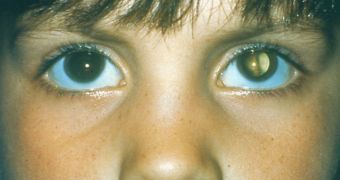The cataract represents an opacity of the crystallin lens produced by the accumulation of insoluble proteins. A teenager's lens contains 3 % of those proteins, while in a person in his/her 80's it can form 40 % of the proteins. This is the main cause of blurred vision and blindness worldwide. Today, in 10 minutes, the opaque lens can be substituted by an artificial implant and annually 5 million people do this.
Now, using matter physics technology, a Swiss team has revealed how a finely tuned interplay of attractions between lens' proteins maintains it transparent and how slight shifts in this balance can make proteins aggregate and de-mix, causing cataract.
This could also explain the formation of protein aggregates in other diseases too, like Alzheimer's disease (the leading dementia cause), the first steps in encountering ways of manipulating and stabilizing protein interactions, impeding the morbid aggregations, or to reverse them once started.
The crystallin lens is composed of densely packed crystallin proteins, whose arrangement makes them transparent. UV light and age can change this, inducing aggregation; the aggregated proteins disperse light and thus the blurred vision results, forecasting blindness. The protein aggregation is irreversible once started, and science has not found any methods to stop it; all that it has been known is that 3 main crystallin proteins are involved in the cataract development.
The interactions between two of the culprit proteins, at ratios similar to those encountered in the eye lens, was investigated through neutron scattering and molecular dynamics computer simulations. It resulted that a delicate attraction/repulsion between the two proteins produced the transparent pattern.
"By combining experiments and simulations it became possible to quantify that there had to be a weak attraction between the proteins in order for the eye lens to be transparent. Our results indicate that cataracts may form if this balance of attractions is disrupted, and this opens a new direction for research into cataract formation." said EPFL postdoctoral researcher Giuseppe Foffi, a member of the Institut Romand de Recherche Numerique en Physique des Materiaux (IRRMA).
"We modeled these proteins as colloidal particles, and found there was a very narrow window in which the protein solution remained stable, and this was a necessary condition for lens transparency," said lead researcher Anna Stradner, physicist at the University of Fribourg.

 14 DAY TRIAL //
14 DAY TRIAL //